MERCEDES-BENZ E-CLASS COUPE 2009 Service Manual
Manufacturer: MERCEDES-BENZ, Model Year: 2009, Model line: E-CLASS COUPE, Model: MERCEDES-BENZ E-CLASS COUPE 2009Pages: 313, PDF Size: 7.76 MB
Page 41 of 313
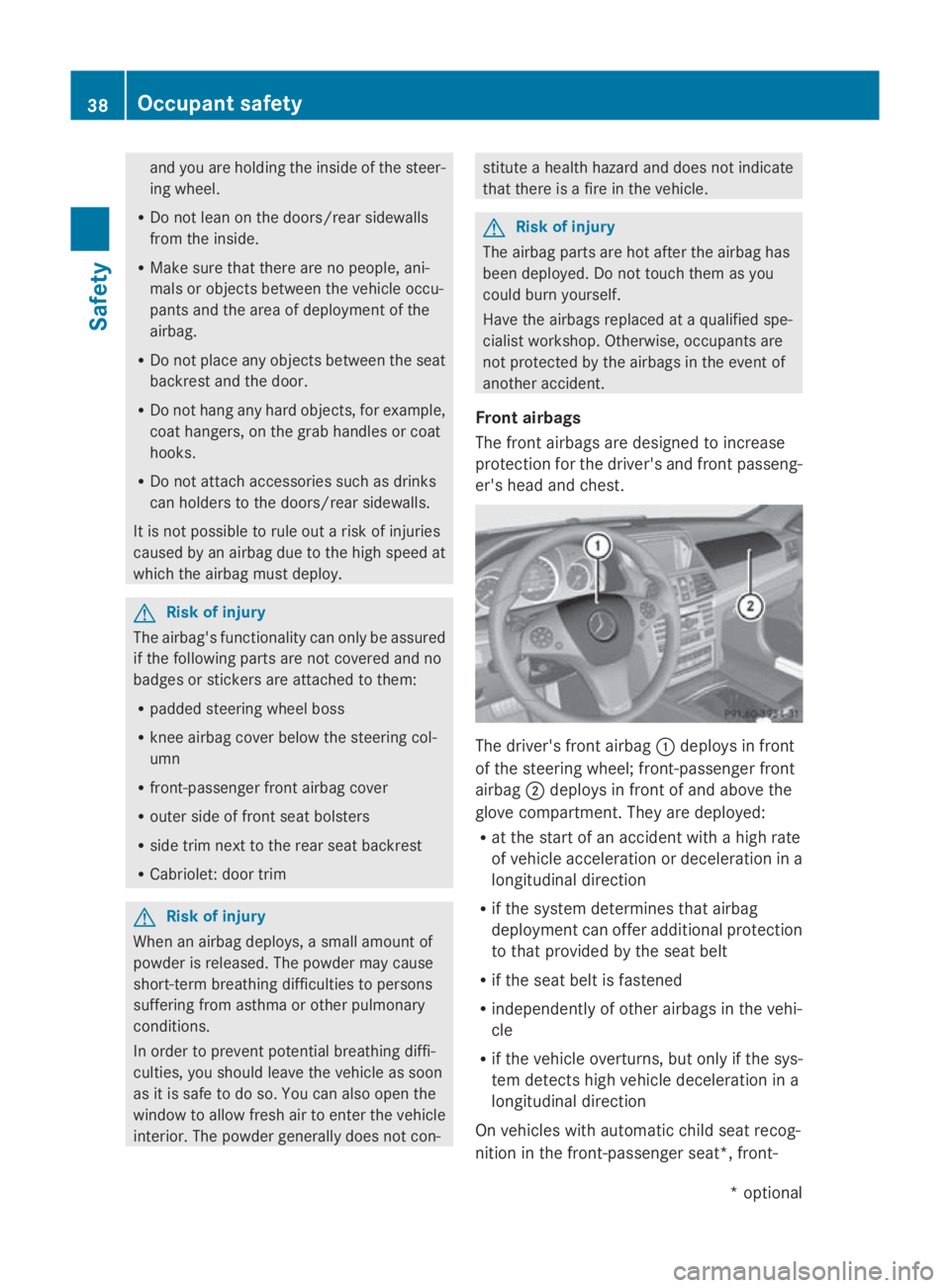
and you are holding th
einside of th esteer-
ing wheel.
R Do no tlean on th edoors/rear sidewalls
from th einside.
R Mak esure that there are no people, ani-
mals or object sbetween th evehicle occu-
pant sand th earea of deploymen tofthe
airbag.
R Do no tplace any object sbetween th eseat
backres tand th edoor.
R Do no thanga ny hard objects, for example,
coat hangers, on th egrab handles or coat
hooks.
R Do no tattach accessories suc hasdrinks
can holders to th edoors/rear sidewalls.
It is no tpossible to rule out arisk of injuries
caused by an airbag due to th ehigh spee dat
whic hthe airbag must deploy. G
Ris
kofi njury
The airbag's functionalit ycan only be assured
if th efollowin gpartsa re no tcovered and no
badges or stickers are attached to them:
R padded steering wheel boss
R knee airbag cover below th esteering col-
umn
R front-passenger fron tairbag cover
R outer side of fron tseat bolsters
R side trim nex ttotherear seat backrest
R Cabriolet :door trim G
Ris
kofi njury
When an airbag deploys, asmall amoun tof
powder is released. The powder may cause
short-term breathin gdifficulties to persons
sufferin gfroma sthma or other pulmonary
conditions.
In orde rtoprevent potential breathin gdiffi-
culties, you shoul dleave th evehicle as soon
as it is safe to do so. You can also open the
window to allow fresh air to enter th evehicle
interior. The powder generally does no tcon- stitut
eahealthhazard and does no tindicate
that there is afireint hevehicle. G
Ris
kofi njury
The airbag part sare hot after th eairbag has
been deployed. Do no ttou ch them as you
coul dburn yourself.
Hav ethe airbag sreplaced at aqualified spe-
cialis tworkshop .Otherwise, occupant sare
no tp rotected by th eairbag sintheeven tof
another accident.
Fron tairbags
The fron tairbag sare designed to increase
protection for th edriver' sand fron tpasseng-
er' sh ead and chest. The driver'
sfront airbag 0046deploys in front
of th esteering wheel; front-passenger front
airbag 0047deploys in fron tofand above the
glov ecompartment. They are deployed:
R at th estart of an acciden twith ahigh rate
of vehicle acceleratio nordeceleratio nina
longitudinal direction
R if th esystem determine sthata irbag
deployment can offer additional protection
to that provided by th eseat belt
R if th eseat belt is fastened
R independently of other airbag sinthevehi-
cle
R if th evehicle overturns, but only if th esys-
te md etect shigh vehicle deceleratio nina
longitudinal direction
On vehicle swith automatic child seat recog-
nition in th efront-pa ssenger seat*, front- 38
Occupant safetySafety
*o
ptional
207_AKB
;2;3,en-GB
mkalafa, Version:2.11.8.1
2009-07-23T10:23:49+02:00
-Seite 38
Page 42 of 313
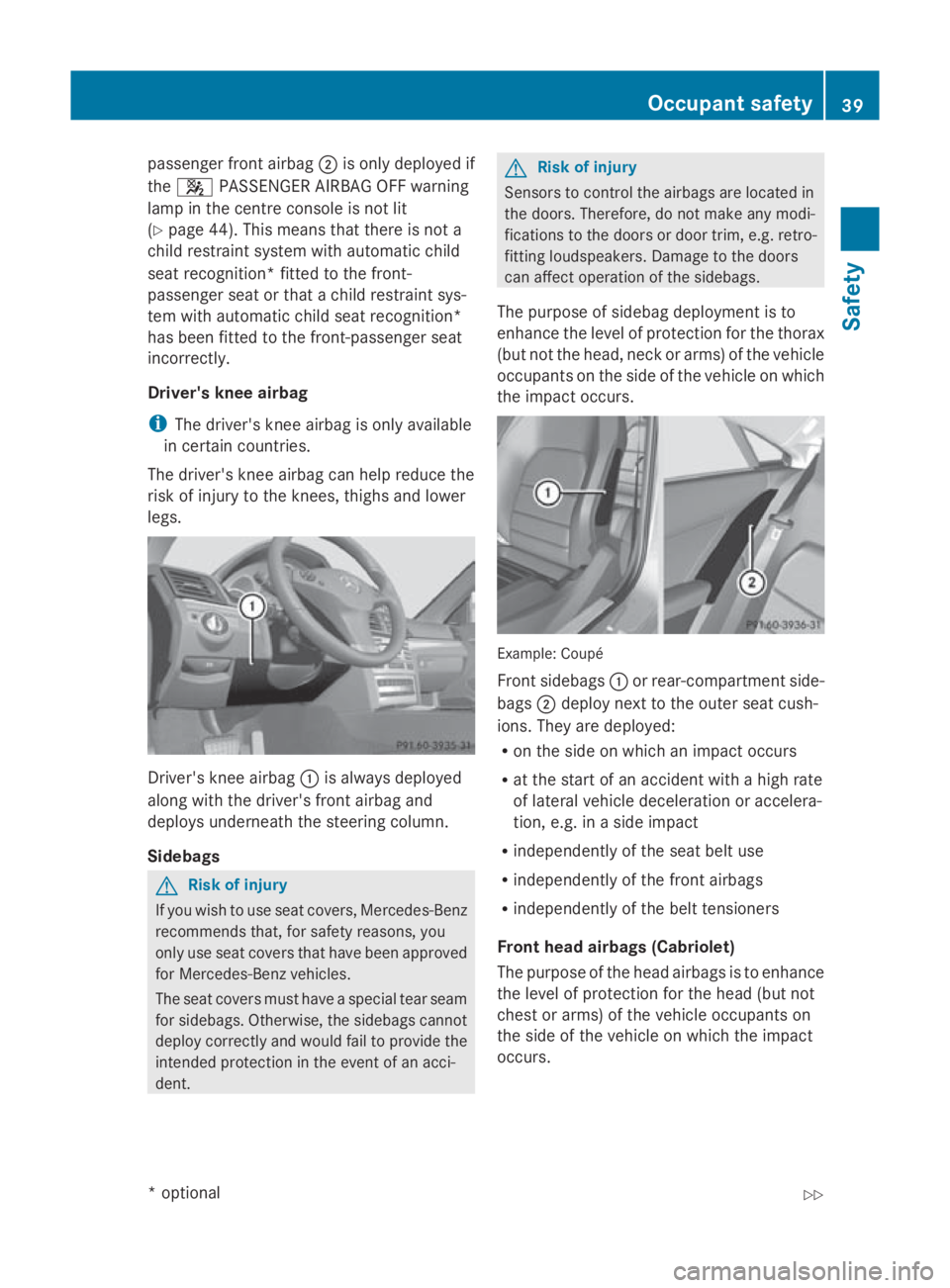
passenger fron
tairbag 0047is only deployed if
the 007F PASSENGER AIRBAG OFF warning
lamp in the centre console is not lit
(Y page 44). This means that ther eisnot a
child restraint system with automatic child
seat recognition* fitted to the front-
passenger seat or that achild restraint sys-
tem with automatic child seat recognition*
has been fitted to the front-passenger seat
incorrectly.
Driver' sknee airbag
i The driver' skneea irbag is only available
in certain countries.
The driver' skneea irbag can help reduce the
risk of injury to the knees, thighs and lower
legs. Driver's knee airbag
0046is always deployed
along with the driver' sfron tairbag and
deploys underneath the steering column.
Sidebags G
Risk of injury
If you wish to use seat covers, Mercedes-Benz
recommends that ,for safety reasons ,you
only use seat cover sthat have been approved
for Mercedes-Benz vehicles.
The seat cover smust have aspecial tear seam
for sidebags. Otherwise, the sidebags cannot
deploy correctly and would fail to provide the
intended protection in the event of an acci-
dent. G
Risk of injury
Sensors to contro lthe airbags are located in
the doors. Therefore, do not make any modi-
fications to the doors or door trim ,e.g. retro-
fitting loudspeakers. Damage to the doors
can affect operation of the sidebags.
The purpose of sidebag deployment is to
enhance the level of protection for the thorax
(but not the head, nec korarms) of the vehicle
occupants on the side of the vehicle on which
the impact occurs. Example: Coupé
Fron
tsidebags 0046or rear-compartment side-
bags 0047deploy nex ttothe outer seat cush-
ions. They are deployed:
R on the side on which an impact occurs
R at the start of an acciden twith ahigh rate
of lateral vehicle deceleration or accelera-
tion ,e.g. in aside impact
R independently of the seat belt use
R independently of the fron tairbags
R independently of the belt tensioners
Front head airbags (Cabriolet)
The purpose of the head airbags is to enhance
the level of protection for the head (but not
chest or arms) of the vehicle occupants on
the side of the vehicle on which the impact
occurs. Occupant safety
39Safety
*optional
207_AKB
;2;3,en-GB
mkalafa, Version:2.11.8.1
2009-07-23T10:23:49+02:0
0-Seite 39 Z
Page 43 of 313
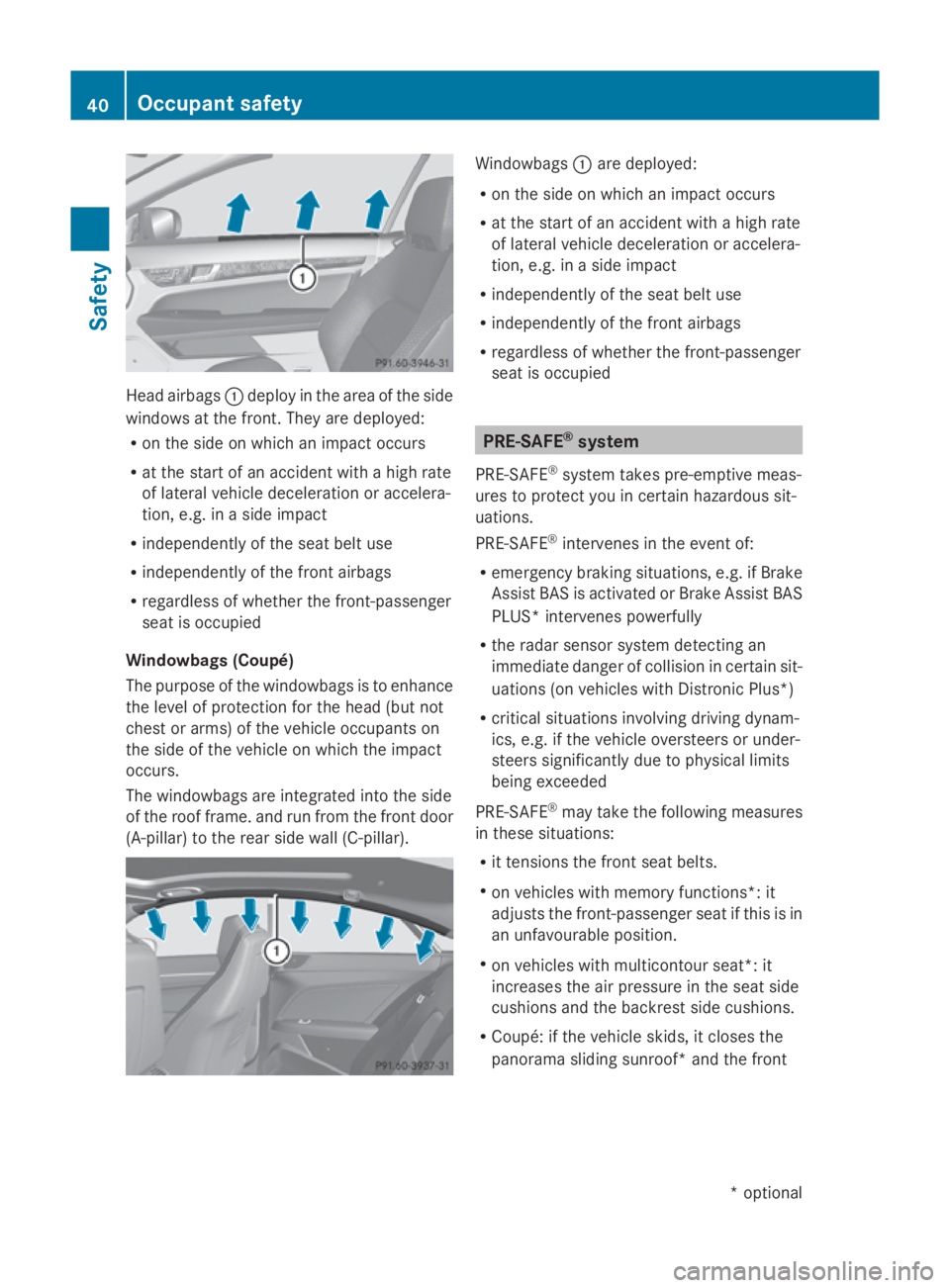
Hea
dairbags 0046deploy in the are aofthe side
window satthe front. The yare deployed:
R on the sid eonwhich an impact occurs
R at the start of an accident with ahighr ate
of latera lvehicle deceleration or accelera-
tion, e.g. in asidei mpact
R independently of the sea tbeltu se
R independently of the front airbags
R regardless of whether the front-passenger
sea tiso ccupied
Windowbags (Coupé)
The purpos eofthe windowbags is to enhance
the level of protection for the hea d(butn ot
chest or arms )ofthe vehicle occupants on
the sid eofthe vehicle on which the impact
occurs.
The windowbags are integrated into the side
of the roof frame. and run from the front door
(A-pillar) to the rea rsidew all( C- pillar). Windowbags
0046are deployed:
R on the sid eonwhich an impact occurs
R at the start of an accident with ahighr ate
of latera lvehicle deceleration or accelera-
tion, e.g. in asidei mpact
R independently of the sea tbeltu se
R independently of the front airbags
R regardless of whether the front-passenger
sea tiso ccupied PRE-SAFE
®
system
PRE-SAFE ®
system takes pre-emptiv emeas-
ure stop rotect yo uincertainhazardou ssit-
uations.
PRE-SAFE ®
intervenes in the event of:
R emergency braking situations, e.g. if Brake
Assis tBAS is activated or Brake Assis tBAS
PLUS* intervenes powerfully
R the radar senso rsystem detecting an
immediate danger of collision in certai nsit-
uations (on vehicles with Distroni cPlus*)
R critica lsituations involving driving dynam-
ics, e.g. if the vehicle oversteer sorunder-
steer ssignificantly du etophysica llim its
being exceeded
PRE-SAFE ®
may take the following measures
in these situations:
R it tensions the front sea tbelts.
R on vehicles with memory functions*: it
adjusts the front-passenger sea tifthis is in
an unfavourable position.
R on vehicles with multicontou rseat*: it
increases the ai rpressur einthe sea tside
cushions and the backrest sid ecushions.
R Coupé: if the vehicle skids, it closes the
panoram asliding sunroof* and the front 40
Occupan
tsafetySafety
*optional
207_AKB; 2; 3, en-GB
mkalafa
,V ersion: 2.11.8.1
2009-07-23T10:23:49+02:00
-Seite 40
Page 44 of 313
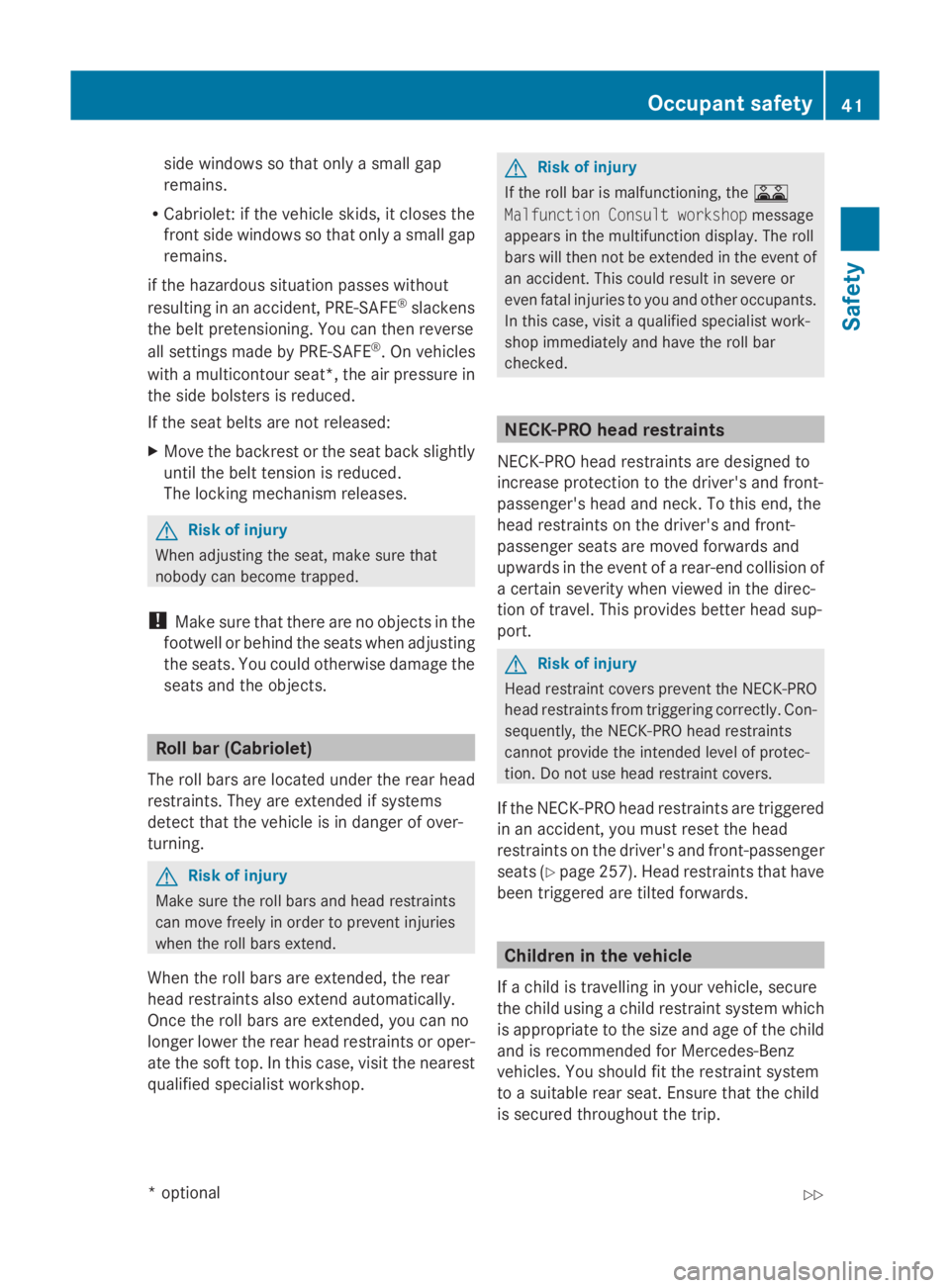
side windows so that only
asmall gap
remains.
R Cabriolet: if the vehicle skids, it closes the
front side windows so that only asmall gap
remains.
if the hazardous situation passes without
resulting in an accident, PRE-SAFE ®
slackens
the belt pretensioning. You can then reverse
all settings made by PRE-SAFE ®
.Onv ehicles
with amulticontour seat*, the air pressure in
the side bolsters is reduced.
If the seat belts are not released:
X Move the backrest or the seat back slightly
until the belt tension is reduced.
The locking mechanism releases. G
Risk of injury
When adjusting the seat, make sure that
nobody can become trapped.
! Make sure that there are no objects in the
footwell or behind the seats when adjusting
the seats. You could otherwise damage the
seats and the objects. Roll bar (Cabriolet)
The roll bars are located under the rear head
restraints. They are extended if systems
detect that the vehicle is in danger of over-
turning. G
Risk of injury
Make sure the roll bars and head restraints
can move freely in order to prevent injuries
when the roll bars extend.
When the roll bars are extended, the rear
head restraints also extend automatically.
Once the roll bars are extended, you can no
longer lower the rear head restraints or oper-
ate the soft top. In this case, visit the nearest
qualified specialist workshop. G
Risk of injury
If the roll bar is malfunctioning, the 0073
Malfunction Consult workshop message
appears in the multifunction display. The roll
bars will then not be extended in the event of
an accident. This could result in severe or
even fatal injuries to you and other occupants.
In this case, visit aqualified specialist work-
shop immediately and have the roll bar
checked. NECK-PRO head restraints
NECK-PRO head restraints are designed to
increase protection to the driver's and front-
passenger's head and neck.Tot his end, the
head restraints on the driver's and front-
passenger seats are moved forwards and
upwards in the event of arear-end collision of
ac ertain severity when viewed in the direc-
tion of travel. This provides better head sup-
port. G
Risk of injury
Head restraint covers prevent the NECK-PRO
head restraints from triggering correctly. Con-
sequently, the NECK-PRO head restraints
cannot provide the intended level of protec-
tion. Do not use head restraint covers.
If the NECK-PRO head restraints are triggered
in an accident, you must reset the head
restraints on the driver's and front-passenger
seats (Y page 257). Head restraints that have
been triggered are tilted forwards. Children in the vehicle
If ac hild is travelling in your vehicle, secure
the child using achild restraint system which
is appropriate to the size and age of the child
and is recommended for Mercedes-Benz
vehicles. You should fit the restraint system
to as uitabler ear seat. Ensure that the child
is secured throughout the trip. Occupant safety
41Safety
*optional
207_AKB;2;3,e
n-GB
mkalafa, Version: 2.11.8.1 2009-07-23T10:23:49+02:00-Seite 41 Z
Page 45 of 313
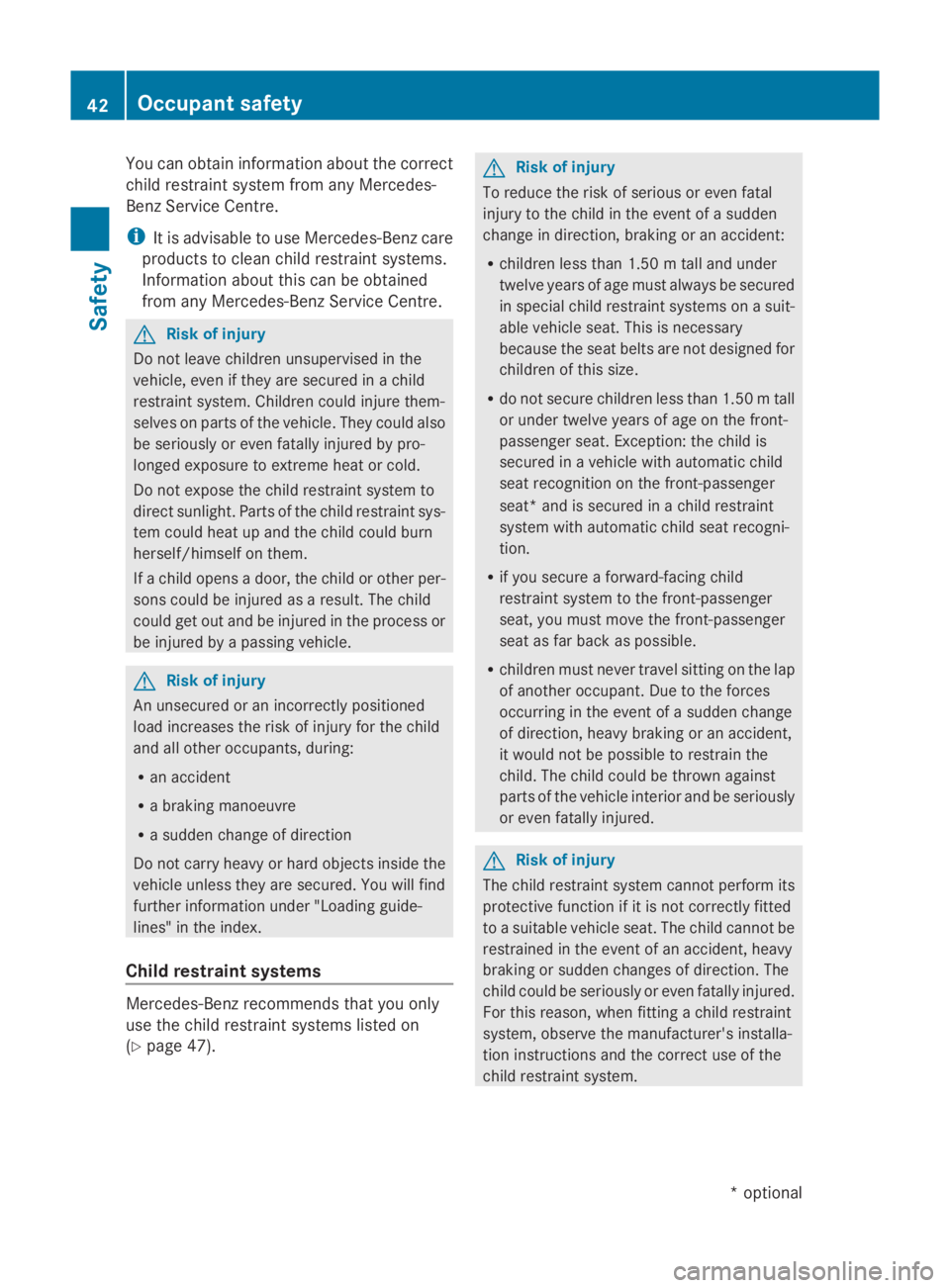
You can obtain information about the correct
child restraint system fro
many Mercedes-
Ben zService Centre.
i It is advisable to use Mercedes-Ben zcare
products to clean child restraint systems.
Informatio nabout this can be obtained
fro ma ny Mercedes-Ben zService Centre. G
Risk of injury
Do not leave children unsupervised in the
vehicle, even if the yare secured in achild
restraint system. Children could injure them-
selves on part softhe vehicle. They could also
be seriously or even fatally injured by pro-
longed exposure to extreme heat or cold.
Do not expose the child restraint system to
direc tsunlight. Part softhe child restraint sys-
tem could heat up and the child could burn
herself/himself on them.
If ac hild open sadoor, the child or other per-
son scould be injured as aresult .The child
could get out and be injured in the process or
be injured by apassin gvehicle. G
Risk of injury
An unsecured or an incorrectly positioned
load increases the risk of injury for the child
and all other occupants, during:
R an accident
R ab raking manoeuvre
R as udden change of direction
Do not carr yheavy or hard object sinside the
vehicle unless the yare secured. You will find
further information under "Loadin gguide-
lines "int he index.
Child restraint systems Mercedes-Ben
zrecommends that you only
use the child restraint systems liste don
( Ypage 47). G
Risk of injury
To reduc ethe risk of serious or even fatal
injury to the child in the even tofasudden
change in direction ,braking or an accident:
R children less than 1.50 mtall and under
twelv eyears of age must always be secured
in special child restraint systems on asuit-
able vehicle seat. This is necessary
because the seat belts are not designed for
children of this size.
R do not secur echildren less than 1.50 mtall
or under twelv eyears of age on the front-
passenger seat. Exception: the child is
secured in avehicle with automatic child
seat recognition on the front-passenger
seat* and is secured in achild restraint
system with automatic child seat recogni-
tion.
R if you secur eaforward-facin gchild
restraint system to the front-passenger
seat, you must move the front-passenger
seat as far back as possible.
R children must never travel sitting on the lap
of another occupant .Due to the forces
occurrin ginthe even tofasudden change
of direction ,heavy braking or an accident,
it would not be possible to restrain the
child. The child could be thrown against
part soft he vehicle interior and be seriously
or even fatally injured. G
Risk of injury
The child restraint system cannot perform its
protective function if it is not correctly fitted
to as uitable vehicle seat. The child cannot be
restraine dinthe even tofana ccident,heavy
braking or sudden changes of direction .The
child could be seriously or even fatally injured.
For this reason ,when fittin gachild restraint
system, observe the manufacturer' sinstalla-
tion instructions and the correc tuse of the
child restraint system. 42
Occupant safetySafety
*o
ptional
207_AKB; 2; 3, en-GB
mkalafa,
Version: 2.11.8.1 2009-07-23T10:23:49+02:00-Seite42
Page 46 of 313
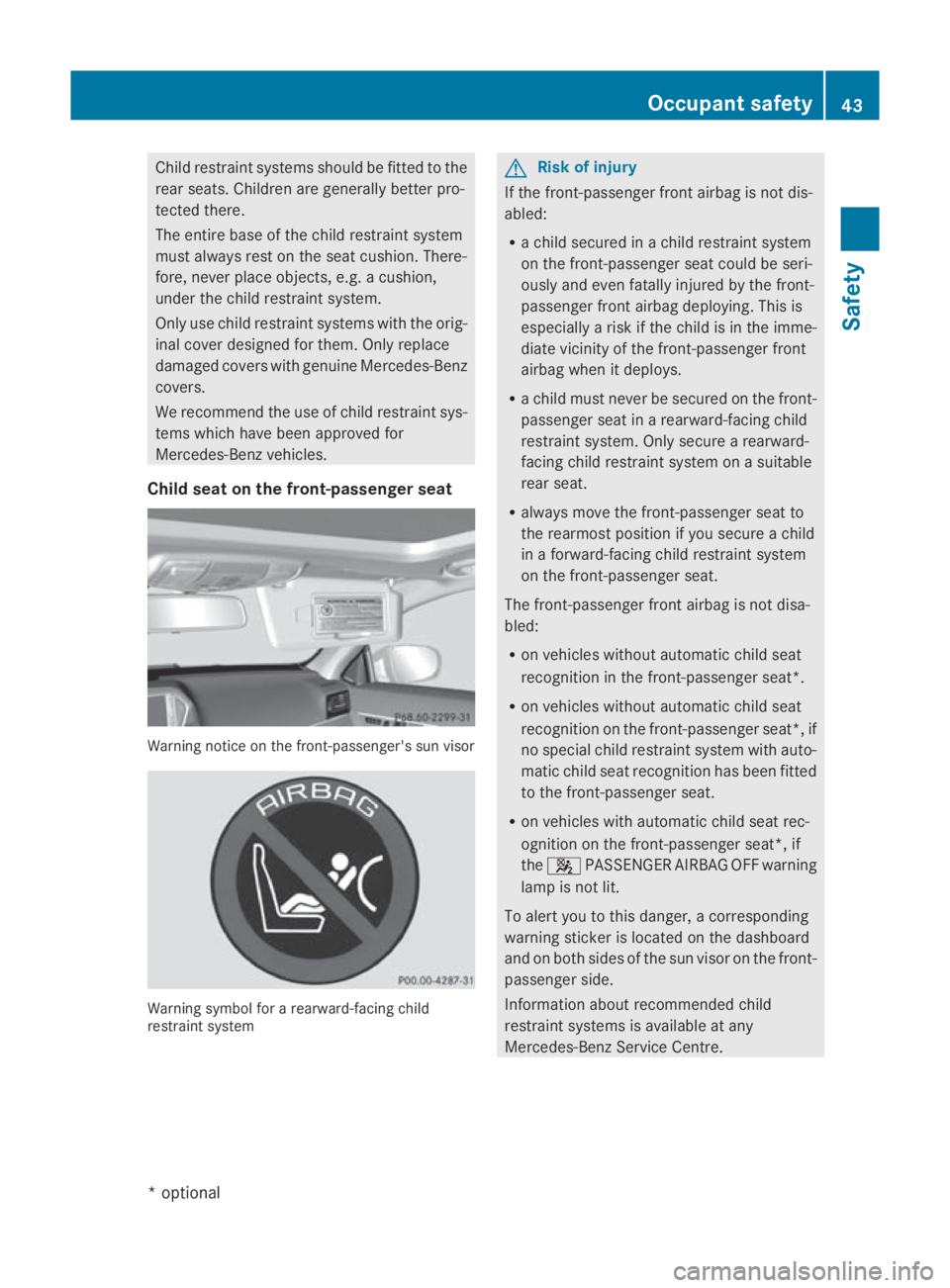
Child restraint systems should be fitte
dtothe
rear seats. Children are generall ybette rpro-
tected there.
The entir ebase of th echild restraint system
must always res tontheseat cushion .There-
fore, never plac eobjects, e.g .acushion,
unde rthe child restraint system.
Only use child restraint systems wit hthe orig-
inal cover designe dfor them. Only replace
damaged cover swithg enuine Mercedes-Benz
covers.
We recommen dthe use of child restraint sys-
tems whic hhave been approve dfor
Mercedes-Ben zvehicles.
Child seat on th efront-passenger seat Warning notic
eonthefront-passenger's sun visor Warning symbol for
arearward-facing child
restraint system G
Ris
kofi njury
If th efront-pa ssenger fron tairbag is no tdis-
abled:
R ac hild secured in achild restraint system
on th efront-pa ssenger seat could be seri-
ously and eve nfatally injured by th efront-
passenger fron tairbag deploying .This is
especiall yariskift hechild is in th eimme-
diat evicinity of th efront-pa ssenger front
airbag when it deploys.
R ac hild must never be secured on th efront-
passenger seat in arearward-facing child
restraint system. Only secure arearward-
facing child restraint system on asuitable
rear seat.
R always mov ethe front-passenger seat to
th er earmos tpositio nifyou secure achild
in af orward-facing child restraint system
on th efront-pa ssenger seat.
The front-passenger fron tairbag is no tdisa-
bled:
R on vehicle swithout automatic child seat
recognition in th efront-pa ssenger seat *.
R on vehicles without automatic child seat
recognition on the front-passenger seat* ,if
no special child restraint system with auto-
matic child seat recognition has been fitted
to the front-passenger seat.
R on vehicles with automatic child seat rec-
ognition on the front-passenger seat*, if
the 007F PASSENGER AIRBAGO FF warning
lamp is not lit.
To alert you to this danger, acorresponding
warning sticker is located on the dashboard
and on both sides of the sun visor on the front-
passenger side.
Information about recommended child
restraint systems is available at any
Mercedes-Benz Service Centre. Occupant safety
43Safety
*optional
207_AKB; 2; 3, en-GB
mkalafa,
Version: 2.11.8.1 2009-07-23T10:23:49+02:00-Seite 43 Z
Page 47 of 313
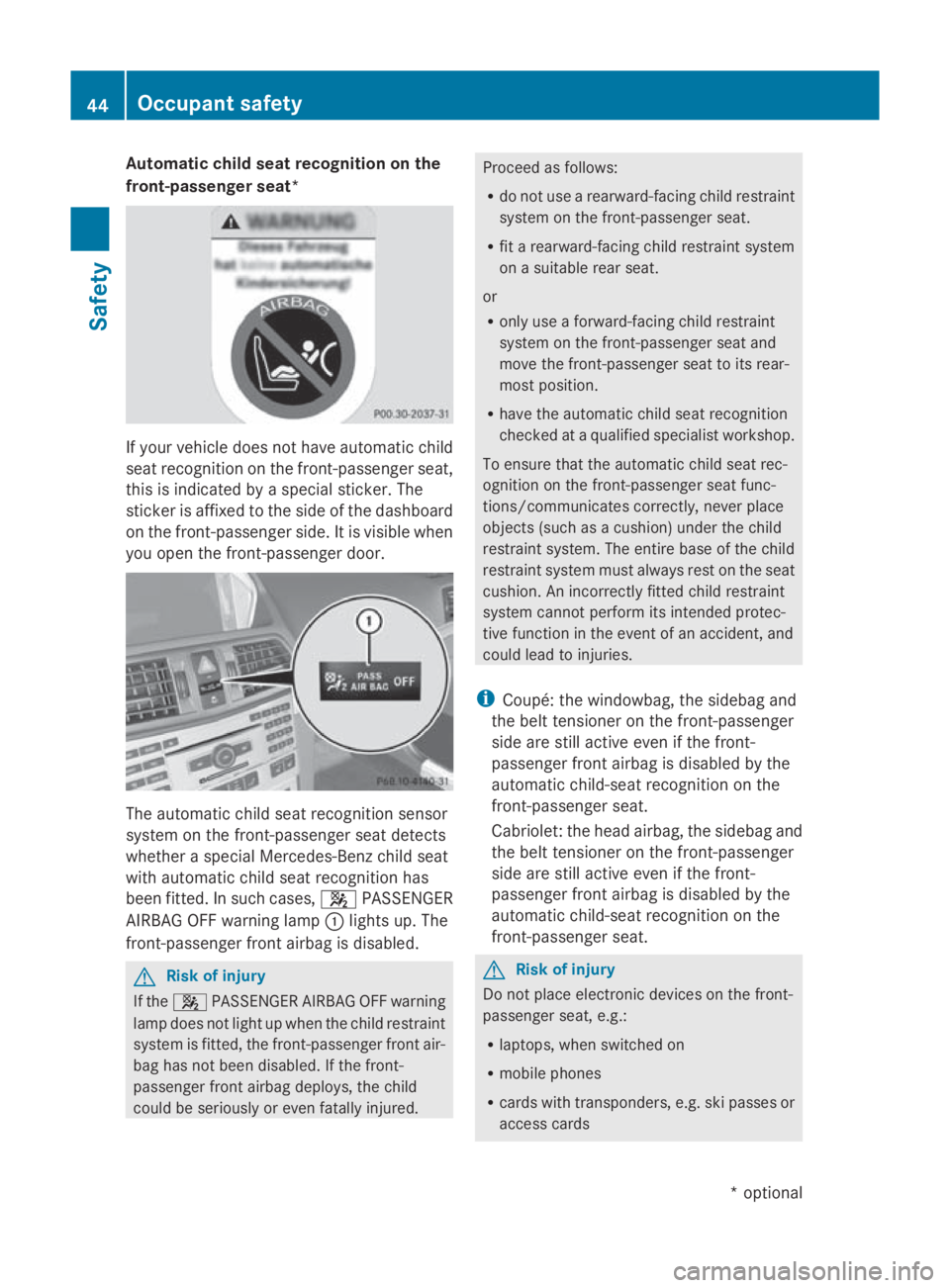
Automatic child seat recognition on the
front-passenger seat*
If your vehicle does no
thave automatic child
seat recognition on th efront-pa ssenger seat,
this is indicated by aspecial sticker. The
sticker is affixe dtotheside of th edashboard
on th efront-pa ssenger side .Itisvisible when
you open th efront-pa ssenger door. The automatic child seat recognition sensor
system on th
efront-pa ssenger seat detects
whether aspecial Mercedes-Ben zchild seat
wit ha utomatic child seat recognition has
been fitted. In suc hcases, 007F PASSENGER
AIRBA GOFFwarning lamp 0046light sup. The
front-passenger fron tairbag is disabled. G
Ris
kofi njury
If the 007F PASSENGER AIRBA GOFFwarning
lamp does no tligh tupw hen th echild restraint
system is fitted, th efront-pa ssenger fron tair-
bag has no tbeen disabled. If th efront-
passenger fron tairba gdeploys, th echild
could be seriousl yorevenf atally injured. Procee
dasfollows:
R do no tuse arearward-facing child restraint
system on th efront-pa ssenger seat.
R fit arearward-facing child restraint system
on asuitable rear seat.
or
R only use aforward-facing child restraint
system on th efront-pa ssenger seat and
mov ethe front-passenger seat to its rear-
mos tposition.
R have th eautomatic child seat recognition
checked at aqualified specialist workshop.
To ensure that th eautomatic child seat rec-
ognition on th efront-pa ssenger seat func-
tions/communicate scorrectly ,never place
object s(suc hasac ushion)under th echild
restraint system. The entir ebase of th echild
restraint system must always res tontheseat
cushion .Anincorrectly fitte dchild restraint
system canno tperfor mits intended protec-
tiv ef unction in th eevent of an accident, and
could lead to injuries.
i Coupé: th ewindowbag ,the sidebag and
th eb elt tensioner on th efront-pa ssenger
side are still active eve nifthefront-
passenger fron tairbag is disabled by the
automatic child-seat recognition on the
front-passenger seat.
Cabriolet :the head airbag ,the sidebag and
th eb elt tensioner on th efront-pa ssenger
side are still active eve nifthefront-
passenger fron tairbag is disabled by the
automatic child-seat recognition on the
front-passenger seat. G
Ris
kofi njury
Do no tplac ee lectronic device sonthefront-
passenger seat ,e.g.:
R laptops, when switched on
R mobile phones
R cards wit htransponders, e.g. sk ipasses or
access cards 44
Occupant safetySafety
*o
ptional
207_AKB
;2;3,en-GB
mkalafa, Version:2.11.8.1
2009-07-23T10:23:49+02:00
-Seite 44
Page 48 of 313
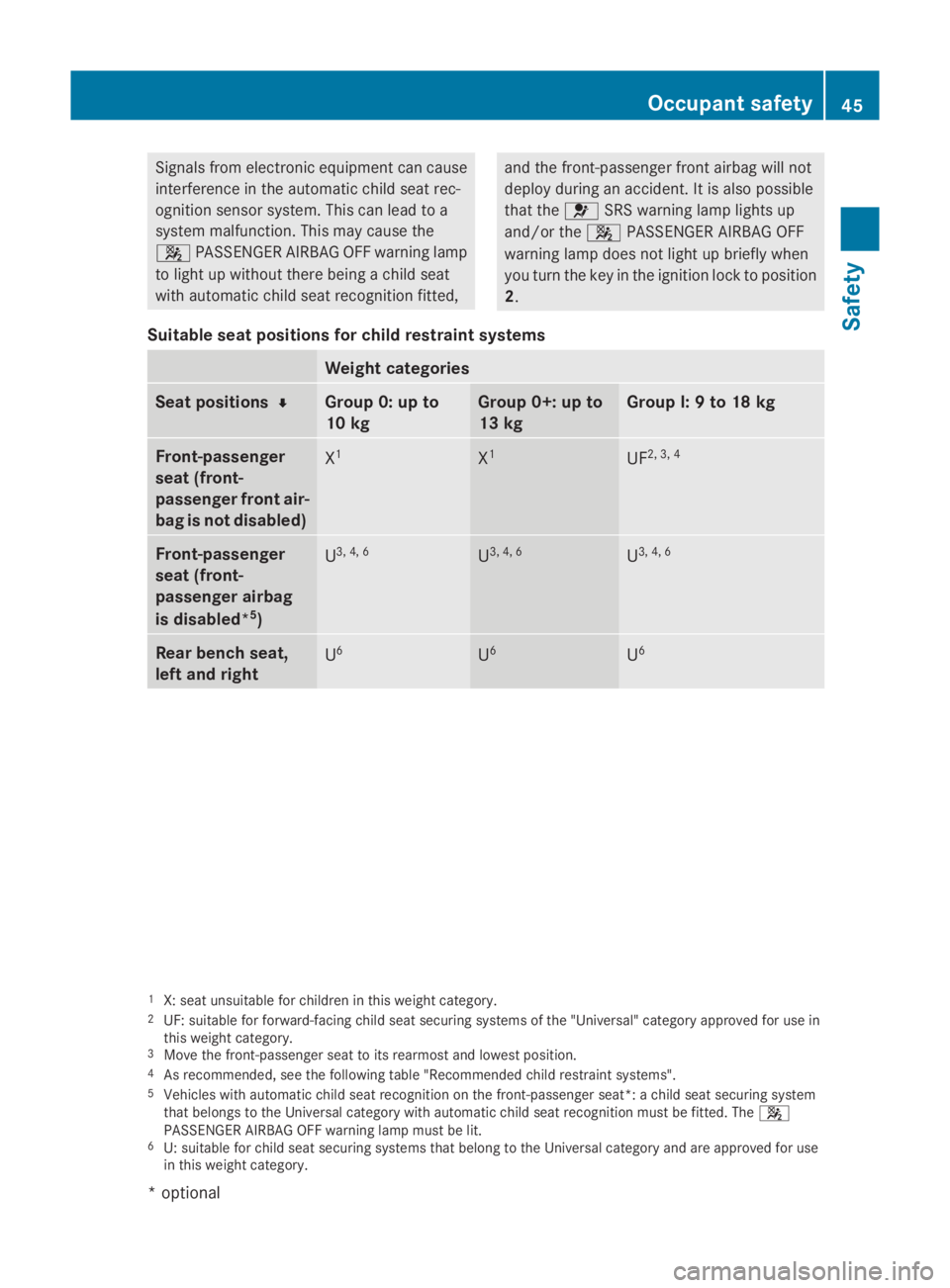
Signal
sfrom electronic equipment can cause
interference in the automatic chil dseatrec-
ognition sensor system. Thi scan lead to a
system malfunction. Thi smay cause the
007F PASSENGER AIRBAG OFF warning lamp
to light up withou tthere being achilds eat
with automatic chil dseatrecognition fitted, and the front-passenger front airba
gwilln ot
deplo yduring an accident. It is also possible
that the 0081SRS warning lamp lights up
and/or the 007FPASSENGER AIRBAG OFF
warning lamp doe snot light up briefl ywhen
yo ut urn the key in the ignition lock to position
2.
Suitabl eseatp osition sfor child restraint systems Weight categories
Seat positions
00CE
00CE Group 0: up to
10 kg Group 0+: up to
13 kg Group I:
9to18kg Front-passenger
seat (front-
passenge
rfron tair-
bag is no tdisabled) X
1 X
1 UF
2, 3, 4 Front-passenger
seat (front-
passenge
rairbag
is disabled* 5
) U
3, 4, 6 U
3, 4, 6 U
3, 4, 6 Rear benc
hseat,
left and right U
6 U
6 U
6 1
X: sea tunsuitable for childre ninthis weigh tcategory.
2 UF: suitabl efor forward-facing chil dseats ecuring systems of the "Universal" categor yapproved for us ein
this weigh tcategory.
3 Move the front-passenge rseattoi ts rearmos tand lowest position.
4 As recommended, see the following table "Recommended chil drestraint systems".
5 Vehicles with automatic chil dseatrecognition on the front-passenge rseat*: achilds eats ecuring system
that belongs to the Universa lcategor ywitha utomatic chil dseatrecognition mus tbefitted. The 007F
PASSENGER AIRBAG OFF warning lamp mus tbelit.
6 U: suitabl efor chil dseats ecuring systems that belong to the Universa lcategor yand are approved for use
in this weigh tcategory. Occupan
tsafety
45Safety
*optional
207_AKB; 2; 3, en-GB
mkalafa
,V ersion: 2.11.8.1
2009-07-23T10:23:49+02:00
-Seite 45 Z
Page 49 of 313
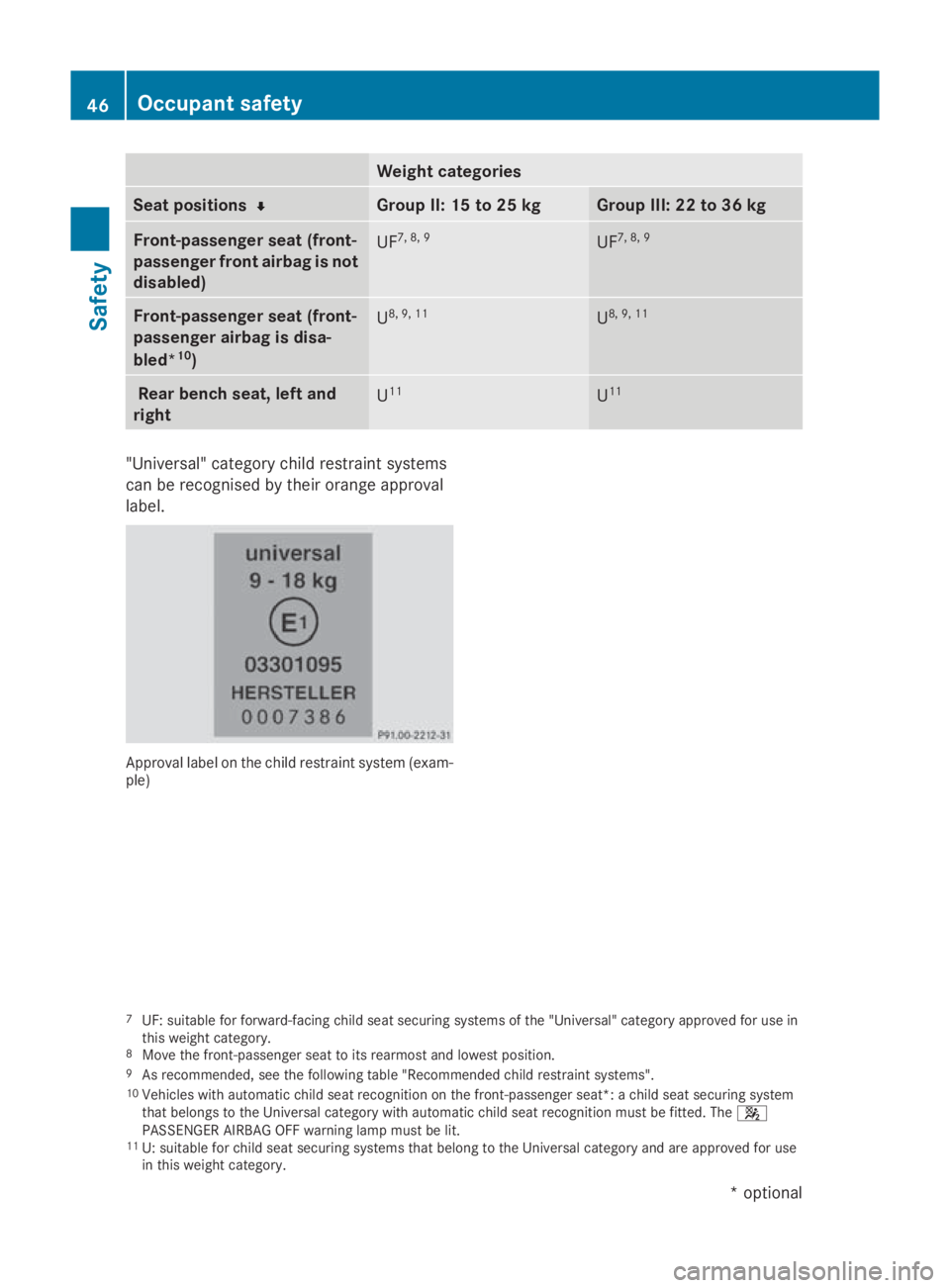
Weight categories
Seat positions
00CE
00CE Group II:15to25kg Group III: 22 to 36 kg
Front-passenger seat (front-
passenger front airbag is not
disabled)
UF
7, 8, 9 UF
7, 8, 9 Front-passenger seat (front-
passenger airbag is disa-
bled*
10
) U
8, 9, 11 U
8, 9, 11 Rear bench seat, left and
right U
11 U
11 "Universal
"category child restraint systems
can be recognised by their orange approval
label. Approva
llabel on the child restraint system (exam-
ple)
7 UF: suitable for forward-facing child seat securing systems of the "Universal "category approved for use in
this weight category.
8 Move the front-passenger seat to its rearmost and lowest position.
9 As recommended, see the following table "Recommende dchild restraint systems".
10 Vehicles with automatic child seat recognition on the front-passenger seat*: achild seat securing system
that belongs to the Universa lcategory with automatic child seat recognition must be fitted. The 007F
PASSENGER AIRBAG OFF warning lamp must be lit.
11 U: suitable for child seat securing systems that belong to the Universa lcategory and are approved for use
in this weight category. 46
Occupant safetySafety
*o
ptional
207_AKB; 2; 3, en-GB
mkalafa,
Version: 2.11.8.1 2009-07-23T10:23:49+02:00-Seite 46
Page 50 of 313
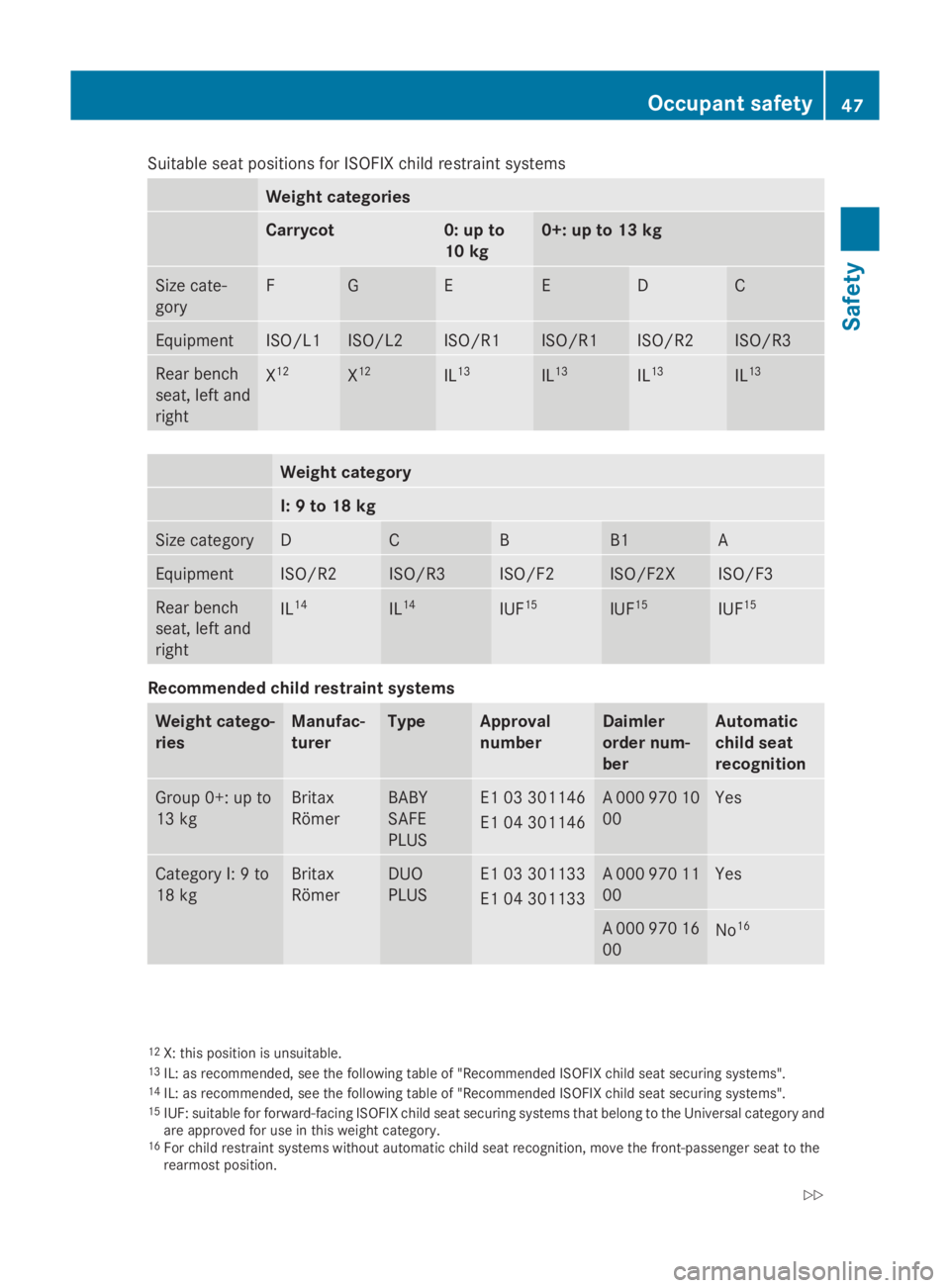
Suitable sea
tpositions for ISOFIX child restraint systems Weight categories
Carrycot 0: up to
10 kg 0+
:upto1 3kg Size cate-
gory F G E E D C
Equipment ISO/L1 ISO/L2 ISO/R1 ISO/R1 ISO/R2 ISO/R3
Rear bench
seat, left and
right
X
12 X
12 IL
13 IL
13 IL
13 IL
13 Weight category
I:
9to18kg Size category D C B B1 A
Equipment ISO/R2 ISO/R3 ISO/F2 ISO/F2X ISO/F3
Rear bench
seat, left and
right
IL
14 IL
14 IUF
15 IUF
15 IUF
15 Recommende
dchild restrain tsystems Weight catego-
ries Manufac-
turer Type Approval
number Daimler
orde
rnum-
ber Automatic
child seat
recognition
Group 0+: up to
13 kg Britax
Römer BABY
SAFE
PLUS E1 03 301146
E1 04 301146 A0
00 970 10
00 Yes
Category I:
9to
18 kg Britax
Römer DUO
PLUS E1 03 301133
E1 04 301133 A0
00 970 11
00 Yes
A0
00 970 16
00 No
16 12
X: this position is unsuitable.
13 IL: as recommended, see the following table of "Recommended ISOFI Xchild sea tsecuring systems".
14 IL: as recommended, see the following table of "Recommended ISOFI Xchild sea tsecuring systems".
15 IUF: suitabl efor forward-facing ISOFI Xchild sea tsecuring system stha tb elong to the Universal categor yand
are approved for us einthis weigh tcategory.
16 For child restraint system swithou tautomatic child sea trecognition, move the front-passenger sea ttothe
rearmos tposition. Occupant safety
47Safety
207_AKB; 2; 3, en-GB
mkalafa,V ersion: 2.11.8.1
2009-07-23T10:23:49+02:00
-Seite 47 Z